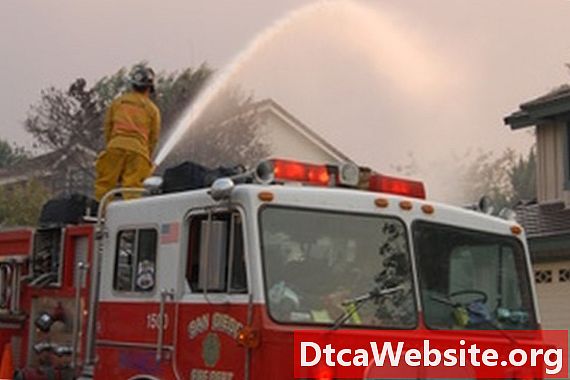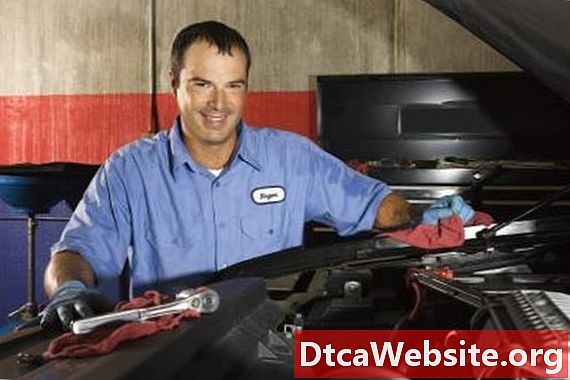
Contenu
- Carburetor Function
- Fixed vs. Variable
- Multibarrel Carburetors
- Carburetors With Catalysts
- Manual Operation

Carburetors were invented in the late-nineteenth century. Since then, carburetor technology has evolved and variations on the original design have been used to produce engines with increased power and efficiency. Today, several distinct types of carburetors exist. Differing in terms of function, complexity and effectiveness, each is appropriate for certain automotive applications.
Carburetor Function
The function of all carburetors is to blend fuel and air in the proper ratio for combustion in an internal combustion engine. Carburetors work on the principle of static and dynamic air pressure. Known as Bernoullis principle, this means that as air is drawn into an engine more quickly, its dynamic pressure will increase. A carburetor meters this pressure, and allows the corresponding amount of fuel to mix with the air. Sidedraft and downdraft carburetors have differently placed intakes, though they achieve the same purpose. These differences in design may be due to the positioning of the carburetor near the engine, or to allow for several carburetors to be stacked on top of each other, where they naturally obscure one surface of the next carburetor in line. Placement of the draft is only useful in keeping the intake clear.
Fixed vs. Variable
Most carburetors fall into one of two large headings: fixed choke or variable choke. Fixed choke carburetors are the most common type, particularly for American cars and trucks. They are usually downdraft carburetors. Fixed choke downdraft carburetors use the pressure of the airflow to regulate the intake of fuel, essentially filling in the space through which fuel would otherwise flow. Variable carburetors, also known as "constant depression" carburetors, are different in that they are usually sidedraft carburetors. They use the pressure of the airflow to regulate fuel intake indirectly. Instead of filling the space as in a fixed choke carburetor, airflow pressure in a variable carburetor activates a connecting pin which in turn narrows or widens the fuel jet. In both cases, the result is the same mixture of fuel and air. The pressure of the airflow, as drawn in by the running engine, will be a function of many factors including engine temperature, the temperature and viscosity of the fuel and the quality of the air itself.
Multibarrel Carburetors
The most simple carburetors contain a single barrel through which the air flows on its way to the engines combustion chambers. Multibarrel carburetors may contain two of four such barrels. This allows more air to flow through the carburetor and is especially useful for engines with larger displacements, since more air is needed in the engine at any given time. Most multibarrel carburetors employ a primary barrel which is activated by the throttle, and a secondary barrel (or a series of secondary barrels) that will only be used when more air is needed and the primary barrel is already at capacity (fully open). In some high performance engine configurations, multibarrel carburetors will allow all barrels to open at once, bypassing the graduated opening that is more useful and efficient on most cars in everyday driving. In other instances, multibarrel carburetors may be used to feed air toward two banks of cylinders, as in a V engine configuration. In these cases, the barrels will be identical and there will be no "primary" or "secondary" designations.
Carburetors With Catalysts
Catalytic carburetors make use of a chemical reaction to alter the quality of the fuel as it mixes with the air. Since one of the important jobs of a carburetor is to evenly mix the fuel and air so that the final product for combustion is homogeneous, impurities and variations in fuel pose a challenge to effective carburetion. Catalytic carburetors contain a catalytic metal, such as platinum or nickel, to break down the fuel into its elemental components so that it will mix more evenly. Although carburetors are largely obsolete in modern cars, the technology of the catalytic carburetor lives on in the catalytic converter, which uses metals to break down engine exhaust into less harmful gasses before they are expelled from the vehicle.
Manual Operation
Some carburetors in specialty applications allow drivers to control more of the carburetors operation manually. The largest group of these are carburetors used in aircraft engines, where air pressure variations that arise from the changing altitude may not be fully compensated for by the carburetors mechanical construction. A pilot-controlled choke allows for an override in cases where more engine power is needed. Another variation on manually controlled carburetors was common on some early motorcycles wide sidedraft layouts. It involved the use of push button known as a "tickler" that would depress the float inside a carburetor, and allow fuel to fill the space inside. This made starting a cold engine easier, but created the risk of flooding the carburetor and spilling fuel on other parts of the engine where it could become a fire danger. Other carburetors have incorporated other forms of manual control for cold starts.


